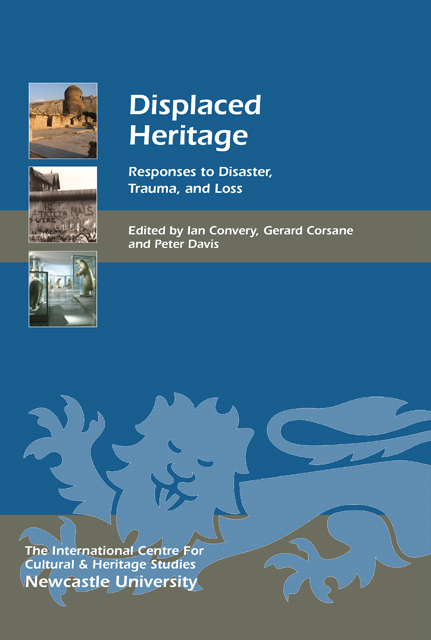Book contents
- Frontmatter
- Contents
- List of Illustrations
- Acknowledgments
- List of Abbreviations
- Preface
- Introduction
- Displaced Heritage: Histories and Tourism
- Displaced Heritage: Trauma, Confinement and Loss
- Displaced Heritage: Lived Realities, Local Experiences
- Displaced Natural Heritage
- Endpiece
- List of Contributors
- Index
- Heritage Matters
Introduction
Published online by Cambridge University Press: 24 February 2023
- Frontmatter
- Contents
- List of Illustrations
- Acknowledgments
- List of Abbreviations
- Preface
- Introduction
- Displaced Heritage: Histories and Tourism
- Displaced Heritage: Trauma, Confinement and Loss
- Displaced Heritage: Lived Realities, Local Experiences
- Displaced Natural Heritage
- Endpiece
- List of Contributors
- Index
- Heritage Matters
Summary
Disasters, whether they are natural or caused by people, change the environment and ‘displace’ heritage resources. They can be dramatic natural impacts such as tsunami and volcanic eruptions, or terrible events unleashed by humankind, including holocaust and genocide. Sometimes disasters are more insidious, such as the logging of rainforests for short-term gain, or elevated sea temperatures, possibly linked to global climate change, that result in thermal stress and bleach coral ecosystems; these may be slower events but their impact is still hugely significant. Disasters can be high-impact events or occur on a small, localised scale. Whether natural or human-made, rapid or slow, great or small, the impact is effectively the same; nature, people and cultural heritage are displaced or lost.
What constitutes ‘disaster’? At first this might seem a fairly straightforward question, but ‘disaster’ eludes simple definition, or as Philip Buckle (2007) puts it, defining disaster is never easy and rarely definitive. Indeed, the word disaster is so frequently used in everyday dialogue, from misplaced house keys to major events such as earthquakes and hurricanes, as to be almost meaningless (Convery et al 2008). This ubiquity is problematic, and as López-Ibor (2005) notes, in academic disciplines it is almost impossible to find an acceptable definition of a disaster. The term originates from the unfavourable aspect of a star, from the French désastre or Italian disastro, and suggests that when the stars are poorly aligned, unfortunate things are likely to happen; the implication is that disastrous events are outside human control. Indeed, disasters may still be viewed as ‘events from the physical environment... caused by forces which are unfamiliar’ (LópezIbor 2005, 2) and frequently unforeseen.
Nesmith (2006, 59) writes that the word disaster has many synonyms that add conceptual significance to the term in communicating misery, death, destruction, helplessness, sudden reversal of what is expected and unhappy resolutions to distressing events. She provides a set of defi ning characteristics:
• Event that disrupts the health of and occurs to a collective unit of a society or community
• The event overwhelms available resources and requires outside assistance for management and mitigation
• Represents tremendous relative human losses
• Negative impact event of natural, financial, technologic, or human origin, for example, armed conflict
• Represents a breakdown in the relationship between humans and the environment
- Type
- Chapter
- Information
- Displaced HeritageResponses to Disaster, Trauma, and Loss, pp. 1 - 6Publisher: Boydell & BrewerPrint publication year: 2014
- 1
- Cited by



